Emerging Product Registration Technologies
Webinar hosted by: Dan Hulkower, SVP After, Inc.
Warranty Innovations Conference
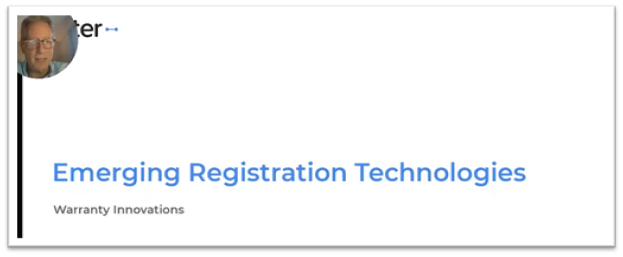
You can listen to the webinar anytime on After, Inc.’s YouTube channel at https://youtu.be/mMbUJxUBTg8
Introduction
Hi, everyone. Welcome. For those of you that don’t know me, I’m Dan Hulkower with After, Inc. After is a Warranty Services company and the majority of our business is selling extended warranties and accessories after the point of sale. So for us, getting product registration data – good registration data – is really our key to success – and the lifeblood of our programs.
A few years ago, we started investing heavily in registration technologies to help our customers get better at it, and built a product called QuickReg™. I’ll talk a little bit today about QuickReg™, but mostly about the registration process and the technologies that have emerged to improve it. I’ll talk about why registration is important. I think everybody knows that, but we’ll just double check. Then, I’ll discuss traditional registration methods, and the three technologies that really started to change things and optimize the registration process. Those technologies are available right now. Then, we’ll talk about emerging technologies like biometrics and how they are going to influence the future of product registration.
Why is Product Registration Important?
So, the first question is why is product registration important?
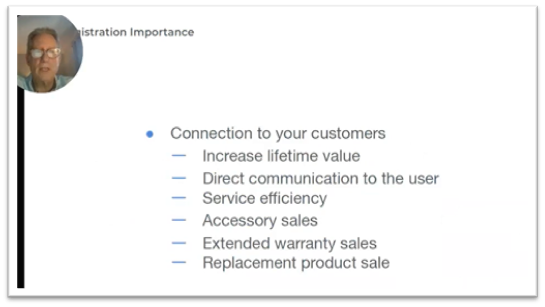
I think we all know that it provides an important connection to your customers. Many of the manufacturers that we work with are selling through dealers, so they have a hard time understanding and finding out who their users are. Getting their products registered gives them a connection to their customers other than when a claim comes in. It also helps increase the lifetime value of those customers because it provides an opportunity to directly communicate with them. It improves the efficiency of service events. It also facilitates accessory sales, extended warranty sales, and most importantly, the next sale. You know when that customer has purchased the product, what product they purchase and when they are near the end of the useful life of that product. Armed with that data, you are in the best position to reach out at the right time with a great offer for them to purchase another one.
Traditional Product Registration Methods
Traditionally for decades, manufacturers just inserted registration cards – and hoped customers mailed them in. For years, 5% was considered a great registration rate. But as recently as five years ago, there was a study that reported 45% of consumers seldom or never registered their products – and for consumers under the age of 30, that number was 62%. The reasons for the low rates were that traditional methods were not simple, easy or convenient. Registration cards weren’t visible at the point of unboxing the product.
We all know it. You get a new product. You’re super excited about it. You open up the box, you throw the information in the packet to the side, and then if you can’t set it up properly, you go back to the packet. I think that that was typical for many people for many years. On top of it, once customers dug into it, the registration process didn’t offer enough value for them to be willing to take the time to give you their personal information.
Here’s the information on who registers – and again this is a couple of years old, but it hasn’t changed too much. It is moving because of some of the newer technologies, but still representative of the way it is today. For consumers between 18 and 29 they seldom or never register their products.

Three Technologies that Changed the Face of Product Registration
1. Mobile Broadband
There are three technologies that changed the face of product registration. First is mobile broadband. Internet speeds are so much faster than they were just 10 years ago. Do you remember dialing up for Internet? I do. And it’s not just that the Internet speeds are so much faster, but you have it all in the palm of your hand right now. We’re carrying the Internet around with us wherever we go. It wasn’t so long ago that you had to go home and dial up and check your check your email.
2. Cloud Computing
The second factor is cloud computing which has made a big difference for the whole product registration area. Now, companies of all different sizes and scales can manage their networks and storage needs on a pay as you go basis.
The three main categories of cloud computing software are: software as a service (SaaS), platform as a service (PaaS), infrastructure as a service (IaaS), More and more, companies have gone to the infrastructure as a service model. What that has done is drive higher operational efficiency, minimize infrastructure expense, and helped businesses become more agile. And it improves your customer communication, connecting to customers 24 by 7. It supports a virtual workforce. I mean, we are all now painfully aware of the need for a virtual workforce and our virtual conferences. But all that is available because of cloud computing. And lastly, cloud computing allows us to deliver a cohesive customer experience, providing that single, unified database for all touch points in all stages of the buyer’s journey. That is all a result of cloud computing.
3. Artificial Intelligence
And the last technological area is artificial intelligence, which has really transformed the way that businesses communicate. There’s been a lot of discussion over the last couple of days about delivering that personalized one-on-one experience. That’s what AI is doing.
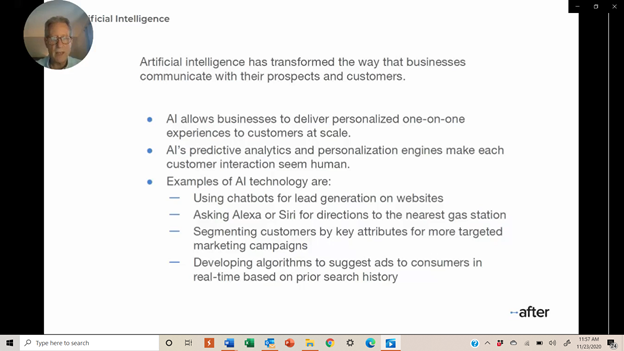
Predictive analytics and personalization make each customer interaction that is done automatically through technology seem human. There was some discussion yesterday about chatbots and what percentage of people think they’re talking to real people when they’re talking to a chatbot. Alexa and Siri – those are also using AI. And AI allows you to segment your customers by key attributes and for more targeted marketing campaigns and develop algorithms to suggest ads in real time based on search history.
Optimizing the Registration Process
So, these three technologies have really helped improve the overall experience, and they’ve driven registration rates up. I think one of the starkest areas – the most obvious areas – is with computers. When you get a new laptop, registration rates for new laptops are over 75% because they’re connected, and you’ve got to go through the Internet right away. I think the amazing thing is that 25% of the people still don’t. But registration rate has become more important in the in the chain of events with a product – and anything that’s connected to the Internet obviously has become a lot easier.

You want to really leverage the technology to make the registration process easy and offer benefits. Once we’ve given the customer a way to register the product, then you have this avenue to communicate with them throughout their product lifecycle. Ownership expands their lifetime value, providing additional upsell opportunities and cross sells, and then increasing your ROI.
Modern Registration Methods that Have Reduced the Friction of Registration
There are three technologies that are available today that have reduced the friction of registration – the number one being QR codes, and I’ll actually give an example of that on the next slide. QR codes have become very prevalent. RFID – that’s where there’s a little chip in a tag that’s either on the box or on the product and has very similar functionality to QR codes, but instead of taking a picture or focusing your camera on it, you just literally touch your phone to the RFID tag and information starts popping up That technology is already embedded in most phones. We’ve talked about texting and chatbots. Those are available widely today. And finally, photo recognition or optical character recognition (OCR), where you take a picture of a receipt and upload it. That then (a) provides a record and (b) gives that information to the manufacturer – and it’s relatively quick and easy.
So all of these registration methods are available today, and are all available through our QuickReg™ application.
But let’s take a second to look at QR codes, because they have really become ubiquitous.
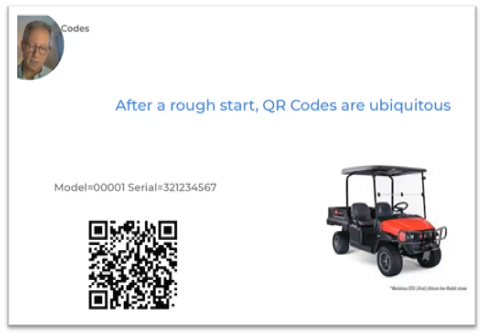
QR codes got off to a rough start because they required you download an app and people either didn’t want to have the app, or maybe the app that they had was the wrong app for a particular QR code. But that’s changed, and they have become universal at this point. The way to use them in case you are not familiar is you just turn your phone camera on, focus it on the QR code. On your camera screen, you’ll get a notification that says “download”. The example above is for Toro, one of our clients. So, if you just scan that QR code, you’d see information pop up about this particular item. You then input the model number, the serial number. QR codes have become very intelligent where you can include the model number in the QR code and personalize the registration process for each customer.
Now, here I am on my phone, which is with me all the time, and I can not only register, but I can access product manuals. I can view parts opportunities. I can see if there any recalls. I can understand what’s available for support for this product. I can buy a service contract. So, all of these things are available through QR codes. We recommend customers put them on the box as well as on the product themselves and the more information that you can embed in QR codes, the easier the process is for the customer, and the more accurate the data you collect will be.
A lot of restaurants are starting to use them now. Customers scan them to get the menu on their phones, so they don’t have to touch it. QR codes and RFID tags are the most common new technology that we see out there. So ordinarily I would ask for questions right now, but I’m not going to because I can’t see them on my computer. But we’ll get to them at the end.
Biometrics for Identification and Security
Let’s talk about some of the things that are in the future and the number one area is biometrics. Biometrics covers a variety of technologies in which unique, identifiable attributes are used to identify and authenticate individuals. So, the first step for registration in the future is going to be identifying individuals through biometrics and then determining what product they purchased. There are a number of different biometrics, both physiological and behavioral. I’m going to talk mostly about the physiological, specifically face, fingerprint and iris, and retina scans.
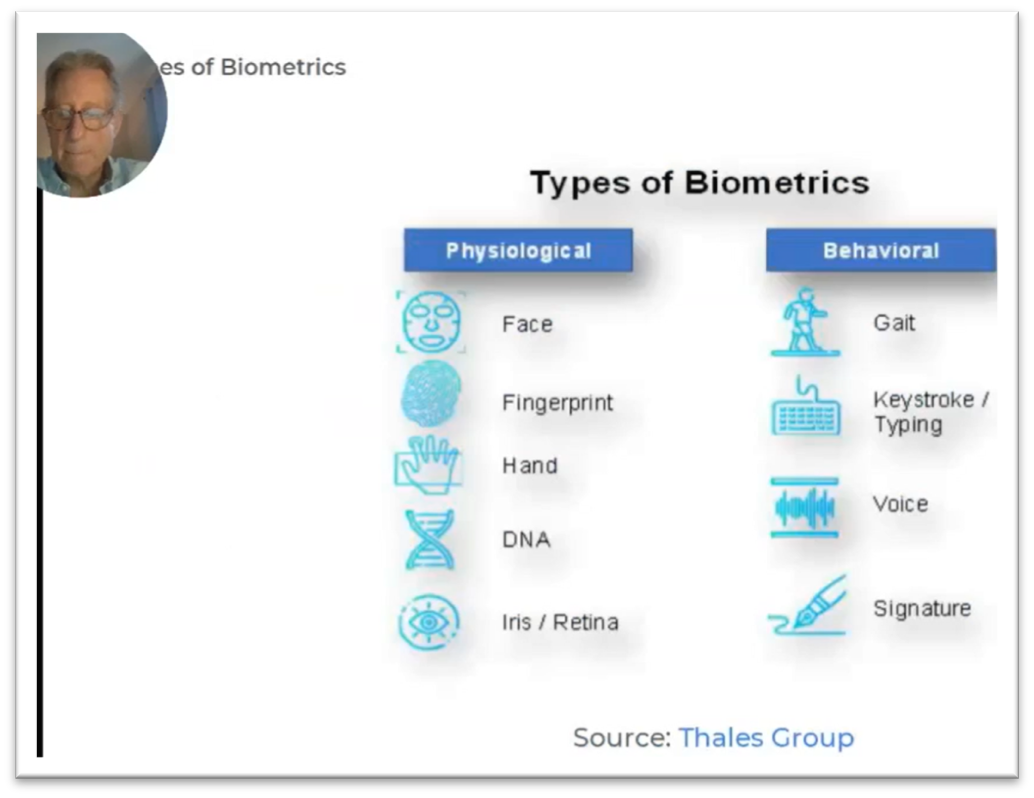
The key factor in biometrics is that they are there universal. They are found in all individuals, they are unique to each person, they are permanent, recordable, measurable and forgery proof. So, the physiological measurements offer the benefit of remaining stable through the life of an individual.
A good example of that is facial recognition. Recently, my daughter turned 30 so I uploaded a photo to Facebook from when she was nine. Facebook’s photo recognition recognized thatand said, this is your daughter, do you want to tag her?” That was both unnerving and impressive. But it’s just an example of how biometrics are permanent, once the technology has captured your facial recognition.
There are a couple of examples of use cases for biometrics. Physical access control biometrics are used on a lot on military bases to prevent unauthorized individuals from accessing high risk areas. You also see retina scans. It’s not just in the movies. Fingerprint scanners allow authorized people into secure environments.
Then there is logical access control. All of us can use a touch ID to unlock our phones. And unbelievably, I was surprised when I saw this number. It’s been going on since 2013! Seven years already for touch ID because it came out on the iPhone. Five years for facial recognition to unlock your phone. And two years for facial recognition to unlock passwords to your phone apps. It’s made it more convenient to improve the security of your phone.
In retail, there’s been uses of facial recognition systems, particularly in the United Kingdom, where they’ve used facial recognition systems to identify shoplifters. In fact, there is an article in The Guardian from 2019 that reported that it had become pointless to report shoplifters to the police because they didn’t do anything. In 2014, there was a law change that made shoplifting of goods below the value of £200 a summary offense instead of a misdemeanor. Police were not spending time and resources going after shoplifters, but it was still a problem for the retailers. So, a number of retailers implemented video cameras and facial recognition software to identify shoplifters and either a keep a close eye on them or just deny them entry into their stores.
Here’s how facial recognition works. It reads the geometry of your face from a photo or from a video and then stores that information to read it again and again.
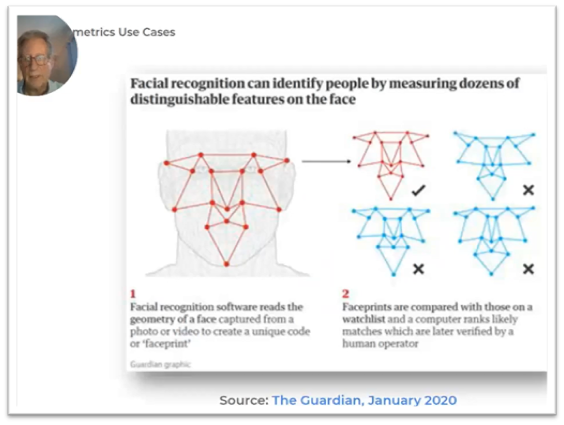
Obviously, every single one is slightly different, so the other piece to this is computer vision. Computer vision is the field of study surrounding how computers see and understand digital images and video. There have been several factors over the last a few years that have taken computer vision accuracy rates from 50% up to 99%. It goes back to mobile technology with built in cameras, and the increase in computing power, and the new hardware designed for computer vision as well as the AI and the creation of algorithms that can understand what it all means and put it all together.
The Impact of These Technologies on the Future of Registration Solutions
So now that I have you sufficiently nervous about how everybody knows everything that you’re doing, let’s talk about how those products will impact future registration technology. We can’t really predict what the future registration solutions are going to look like. But we can say with confidence they will likely include both biometrics and computer vision because the benefits are too great to ignore. Biometrics provides stronger security and login verification. We’ve seen it. Most application providers are now incorporating two factor authentication into their solutions. It’s very effective at keeping security at a high level. And the result is that consumers are open to providing their personal data if they believe that they’ll get some value for it – if they can control what is stored and if they believe it will be kept safe. Two factor authentication – incorporating facial recognition with a pin – will likely become the industry standard for all mobile applications.
Similarly, computer vision will help improve the customer experience and drive higher registration rates. Mobile registration has made it so much easier. It will continue to make it easier and more convenient to register products. There will be no barcode or serial number required so they will be more likely to follow through with the registration process.
Currently, if you want to register something, you have to snap that barcode or you need to scan the QR code. In the future, you could just take a picture of your product and send it in. Once you’ve agreed to terms and conditions and sent in the picture of your product, the manufacturer will know that this is the product you own and this is who you are.
Conclusion
It’s interesting to think about how it’s going affect us, but I think more and more people are going be using that type of registration. The future of registration may be closer than we think. You know, fingerprint on facial identification is already here. And as image and video identification become more and more mainstream, it’s just a matter of time before they become part of product registration.
So if you’d like to learn more about QuickReg™ and our smart registration process, please reach out to me or any other After, Inc. employees that are here at the conference. I’m going to stop now and see if there any questions on the chat box.
A question from Henry. Yes, Henry, there are privacy concerns, and, you know, it’s interesting. I think there’s going to be a lot of this captured in the terms and conditions, which is a little scary. I read recently that if you were to read all of the terms conditions that are presented to you in a typical year, it would take you five eight-hour days, basically an entire week of just reading terms and conditions. So, I think that terms conditions are going to have to evolve so that they’re easier because people are just going to say no, you can’t share my information. You can’t have any of my information. I think that that’s another area that needs to be further developed.
Any other questions out there? Any other thoughts? All right. Well, I appreciate everybody’s time. Thanks for coming out to the conference and coming and listening to my talk today. I hope to speak to each one of you soon.
To learn more about After, Inc. solutions, please visit www.afterinc.com.





